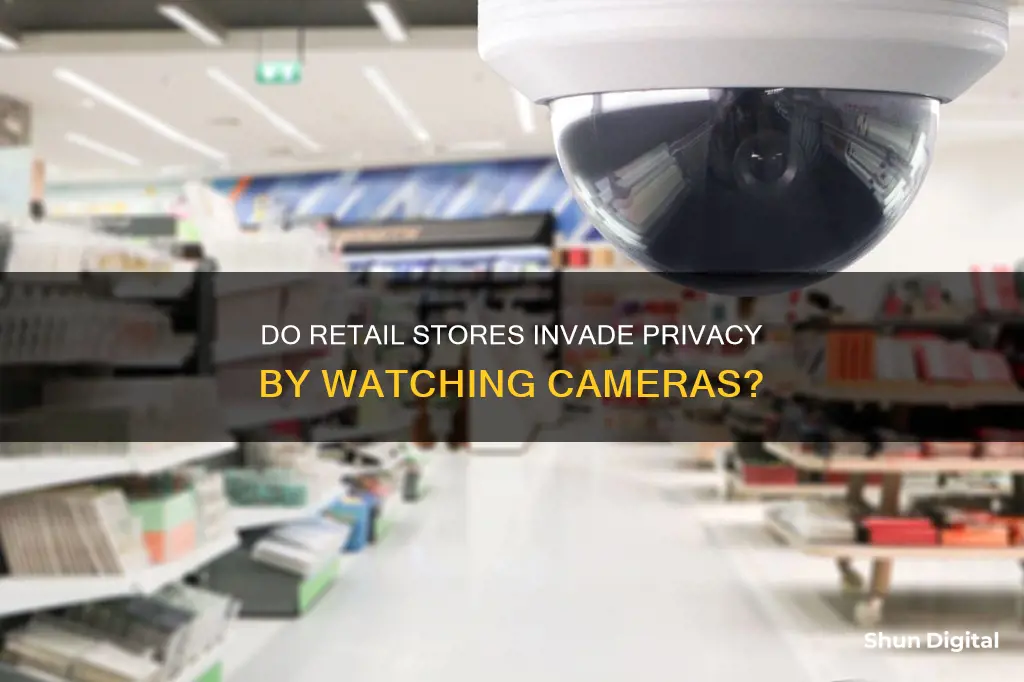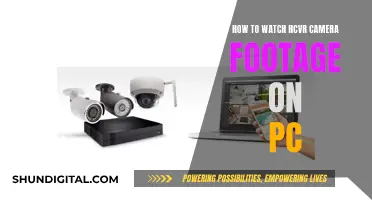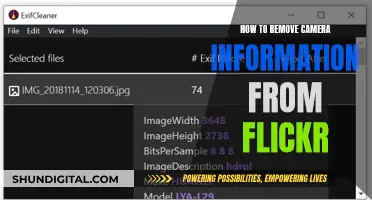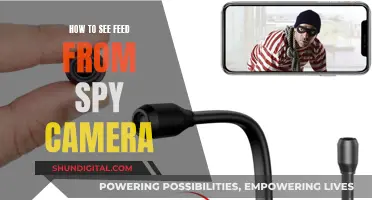
Security cameras are a common feature in retail stores, and their presence is often justified as a means to prevent theft and improve efficiency. While some stores may have employees dedicated to monitoring these cameras, it is more common for larger stores with higher budgets to employ such measures. Smaller stores often rely on recording footage that can be reviewed in the event of an incident. The use of security cameras in retail stores has sparked a debate about the balance between deterring crime and invading privacy. While some argue that the presence of cameras makes customers feel safer, others question the effectiveness of this security measure, suggesting that it may be more of a scare tactic.
| Characteristics | Values |
|---|---|
| Purpose | Prevent theft, improve efficiency, monitor employees, deter crime, improve customer experience, etc. |
| Camera Types | Turret, dome, fisheye |
| Camera Placement | Shipping and receiving area, sales floor, parking lots, entrances and exits, stockroom, point of sale |
| Camera Features | Remote access, 24/7 recording, night vision, scalability |
| Monitoring | Done remotely, in real-time, or after an incident |
| Monitoring Personnel | Loss prevention professionals, asset protection professionals, managers, security guards |
What You'll Learn

Cameras are monitored in real-time by loss prevention officers
Loss prevention plays a critical role in maintaining profit margins for retail stores and malls. Implementing a retail surveillance system with remote access is a powerful way to deter theft and catch shoplifting incidents in real-time.
Retail security systems with remote access allow managers, store owners, and loss prevention officers to view video feeds from anywhere. This is essential for preventing shoplifting and theft, which often occurs when only loss prevention officers are not looking or are monitoring another area of the store.
In addition to deterring theft, real-time monitoring of security cameras can also help improve employee productivity and optimize the customer shopping experience. For example, by identifying unsafe or inefficient practices and correcting them promptly, as well as tracking employee performance over time in an objective manner.
While some stores may primarily rely on recorded footage that can be reviewed after an incident, larger retail chains and stores with high-value items often have dedicated staff monitoring security cameras during business hours. This can include loss prevention officers or even remote camera operators who are direct employees of the company.
The presence of loss prevention officers monitoring security cameras in real-time can provide an effective deterrent to theft and improve overall store security. This proactive approach to loss prevention can be particularly important for stores located in areas with high theft or security concerns.
By having dedicated staff monitoring security cameras, retailers can also ensure that any suspicious activity is promptly addressed and that appropriate action is taken to prevent incidents from escalating. This can include coordinating with security personnel on the ground or notifying law enforcement as needed.
In summary, cameras monitored in real-time by loss prevention officers play a vital role in retail security and loss prevention. This approach not only helps deter theft and improve store security but can also positively impact employee productivity and the overall customer experience.
Laptop Camera: Am I Being Watched?
You may want to see also

Cameras are only monitored after an incident
In most retail stores, security cameras are not monitored in real-time, and footage is only reviewed after an incident. This is especially true for smaller or lower-budget stores. Larger, pricier stores are more likely to have people actively watching the security cameras, in addition to employing security guards disguised as shoppers.
Retail stores use security cameras for a variety of reasons, including loss prevention, optimising the customer experience, and monitoring employee productivity and compliance. The presence of security cameras can also act as a deterrent to theft, with the accurate impression that any criminal activity will be documented.
While security cameras are an effective tool for monitoring retail stores, they are not always actively monitored. This is due to the high cost of hiring staff to watch the footage in real-time, as well as the impracticality of doing so for large stores with many cameras. Instead, stores often rely on recorded footage that can be reviewed after an incident has occurred. This allows them to identify and resolve issues efficiently, without incurring unnecessary labour expenses.
In some cases, retail stores may have someone monitoring the cameras during specific periods, such as peak business hours or when there is a higher risk of theft. This person may be a dedicated security staff member or a manager who has access to the camera feeds. However, it is more common for stores to rely on recorded footage that can be reviewed as needed, rather than actively monitoring the cameras at all times.
Overall, while security cameras are an important tool for retail stores, they are often used reactively rather than proactively, with footage being reviewed after an incident has occurred rather than in real-time. This allows stores to balance the need for security and loss prevention with the practical and financial constraints of actively monitoring all cameras at all times.
Mobile Cameras and Solar Eclipse: Safe or Not?
You may want to see also

Cameras are monitored by managers
Retail stores have security cameras for a number of reasons, including to prevent theft and improve efficiency. While some stores have people dedicated to watching the cameras, this is not always the case. In some stores, managers are responsible for monitoring the camera footage. This can be done remotely and allows managers to keep an eye on the store when they are not physically present. This can be particularly useful for managers of multiple stores, as it allows them to monitor several locations at once.
Managers can use camera footage to identify and resolve incidents of theft, both by customers and employees. This helps to improve loss prevention and can also be used to identify procedural weaknesses that make theft possible. For example, a manager might review footage to see if employees are following proper procedures when unloading merchandise or checking manifests.
In addition to preventing theft, managers can use camera footage to monitor employee performance and identify areas for improvement. This can include unsafe or inefficient practices, as well as underperforming employees. By reviewing the footage, managers can provide targeted training and feedback to improve overall store performance.
Camera footage can also be used to improve the customer experience. For example, managers can use it to identify areas of the store that need more staff or to set staffing schedules based on customer traffic. This helps to reduce cashier line backups and improve the overall flow of the store.
In some cases, managers may also use camera footage to ensure compliance with health and safety regulations. For example, they can review footage to ensure that emergency exits are not blocked and that employees are following proper safety procedures. This can help to reduce the risk of fines and create a safer environment for customers and employees.
Overall, while it is not always the case that managers are responsible for monitoring camera footage, it is clear that they play a key role in utilizing the information gathered from security cameras to improve store operations, prevent loss, and enhance the customer experience.
Finding the Best Spots to Mount 15 Cameras
You may want to see also

Cameras are monitored by security guards
Security guards play a vital role in monitoring cameras at retail stores. While the extent of active monitoring varies, security guards are often responsible for observing camera footage to deter and prevent theft, ensure employee compliance, and maintain a safe environment for customers and staff.
In large retail chains or stores located in high-crime areas, security guards may be dedicated to monitoring camera feeds during business hours. This allows for prompt responses to suspicious activities and provides an additional layer of security beyond recorded footage. Security guards can also receive alerts or notifications when specific events or activities are detected by the cameras, enabling them to take immediate action.
In addition to theft prevention, security guards monitoring cameras can help identify unsafe practices, inefficient procedures, or non-compliance with company policies or health and safety regulations. For instance, they can detect blocked emergency exits, unsafe equipment handling, or employees not adhering to mask mandates. This proactive monitoring helps maintain a safe environment and can prevent accidents or incidents that may lead to fines or legal consequences.
Security guards can also play a crucial role in optimizing customer service standards. By reviewing camera footage, they can identify areas where additional staff training is needed, such as proper greeting of customers or assistance with product inquiries. This helps ensure that customers receive consistent and high-quality service throughout the store.
Furthermore, security guards can utilize camera systems to monitor employee performance and identify underperforming staff. This information can then be used to implement targeted training programs or performance improvement initiatives. Additionally, by pairing transaction data with video footage, security guards can assist in identifying and resolving instances of employee theft or fraud, such as discount abuse or return fraud.
In summary, security guards play a vital role in monitoring cameras at retail stores. Their presence provides an effective deterrent to criminal activities, enhances loss prevention efforts, ensures compliance with safety regulations, and helps maintain excellent customer service standards. By actively observing camera feeds, security guards contribute to a safer and more secure shopping environment for customers and staff alike.
School Bus Camera Footage: Who's Watching?
You may want to see also

Cameras are monitored by AI
Cameras in retail stores are increasingly being monitored by AI, which is transforming the way these businesses operate. AI video analytics can be used to identify products by packaging, shape, and size, and even distinguish between different types of fruits and other loose goods. This technology can be used to automate operations, improve inventory management, and enhance the customer experience.
AI-enabled cameras in retail stores offer several benefits. Firstly, they can help retailers make data-informed decisions by providing valuable insights into customer behaviour and preferences. This includes tracking customer movements, analysing demographics, and performing sentiment analysis. This information can be used to optimise staffing decisions, improve inventory management, and enhance marketing strategies.
Another advantage of AI-monitored cameras is their ability to detect and prevent theft. AI tools can work as scanning systems on video recording devices, alerting staff to any suspicious activity. This not only improves security but also reduces the risk of financial loss. Additionally, AI can be used to monitor stockroom utilisation, ensuring that stock levels are optimised and reducing the risk of theft.
AI-enabled cameras can also contribute to supply chain optimisation. By analysing customer buying patterns and preferences, AI tools can help retailers make informed decisions about inventory management and supply chain processes. This enables retailers to optimise their operations and improve efficiency.
While AI-monitored cameras offer numerous benefits, it is important to consider ethical implications and privacy concerns. Retailers must ensure that the use of AI-enabled cameras is transparent to customers and that appropriate measures are in place to protect customer data and privacy.
Cameras: Always Watching, Always Listening?
You may want to see also
Frequently asked questions
It depends on the store. Most large retail stores have people monitoring the security cameras during peak hours or business hours. Smaller stores or those with lower budgets may not have the capacity to employ someone to monitor the cameras, so they may only review the footage if an incident occurs.
Security cameras help prevent theft and improve employee productivity. They can also be used to enhance the customer experience and ensure compliance with health and safety regulations.
Common types of security cameras used in retail stores include turret cameras, dome cameras, and fisheye cameras. Turret cameras offer flexible positioning, while dome cameras provide protection against vandalism. Fisheye cameras, or 360 cameras, offer a complete 360-degree view, making them ideal for monitoring large areas.
Security cameras should be placed to provide complete coverage of the store, including parking lots, entrances, exits, shipping and receiving areas, stockrooms, sales floors, and point-of-sale systems.
While some retailers may use hidden security cameras, visible cameras are more common. Hidden cameras are less effective at deterring crime, and visible cameras can make customers feel safer.







